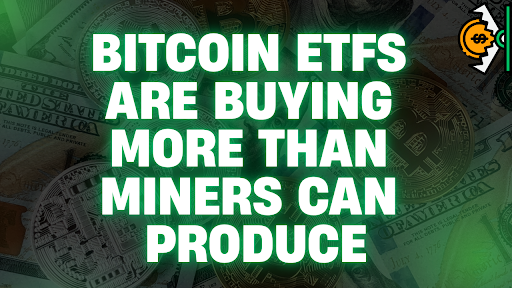- Bitcoin ETFs are now buying far more than miners can produce each week.
- This growing demand is tightening supply and may drive prices higher.
- The market is watching closely to see how long this imbalance will last.
In a surprising twist that’s shaking up the crypto world, U.S. spot Bitcoin exchange-traded funds (ETFs) have bought over 21,000 BTC in just one week, while Bitcoin miners only produced around 3,150 BTC during the same time. This major gap between supply and demand is raising new questions about the future of Bitcoin’s price and availability. Let’s take a closer look at what’s going on, why it matters, and what it could mean for investors and the broader market.
A Closer Look at the Numbers
Bitcoin is created through a process called mining. On average, about 900 new bitcoins are mined each day, which adds up to around 3,150 coins every week. However, demand for Bitcoin has recently surged, especially from institutional investors who are now gaining easier access to it through spot Bitcoin ETFs.
Spot Bitcoin ETFs allow investors to gain exposure to Bitcoin without having to directly buy or store it themselves. These funds hold actual Bitcoin, which means that when investors put money into an ETF, the fund must go out and buy real BTC to back those shares. Over the past week, these ETFs bought over 21,000 BTC—nearly seven times more than what was newly mined.
This imbalance is significant. It’s one thing for ETFs to buy large amounts of Bitcoin, but it’s another when they consistently absorb more than the entire newly mined supply. When demand outpaces supply like this, it can push the price higher and lead to tighter availability for other buyers.
Why Spot Bitcoin ETFs Are Driving Demand
Ever since the U.S. Securities and Exchange Commission approved several spot Bitcoin ETFs in early 2024, interest from institutional investors has been growing. Big names like BlackRock, Fidelity, and Greyscale have launched their ETFs, and these funds have quickly attracted billions of dollars.
What makes these ETFs appealing is the simplicity and safety they offer. Traditional investors—such as pension funds, wealth managers, and hedge funds—prefer regulated, familiar investment products. ETFs provide that structure while offering direct exposure to Bitcoin’s price movements.
As more money flows into these ETFs, the funds are forced to keep buying more BTC to match investor demand. That’s what we’re seeing now: large-scale buying that far exceeds what miners can supply. And with each passing week, this trend appears to be gaining momentum.
What Happens When Demand Outpaces Supply
Bitcoin’s supply is capped at 21 million coins. It’s a fixed limit hardcoded into the protocol, which is part of what gives the asset its appeal as “digital gold”. The mining rate also decreases over time through events called halvings, which occur roughly every four years. The most recent halving in April 2024 cut the daily mining reward in half, reducing the new supply entering the market.
So when ETFs scoop up nearly all—or, in this case, much more than all—newly mined BTC, they’re reducing the amount available for other buyers. This creates a supply squeeze. And just like in any market, when supply shrinks and demand grows, prices tend to rise.
Some analysts believe this could lead to a long-term bull run in Bitcoin’s price. Others warn that sudden surges in demand can create short-term volatility. Either way, it’s clear that ETF activity is now playing a major role in shaping Bitcoin’s price movements.
How This Could Impact Investors
For everyday investors, this trend could be both exciting and concerning. On one hand, increased demand from institutional players can validate Bitcoin as a serious asset class and potentially support higher prices. On the other hand, rising prices might make it harder for new investors to buy in at attractive levels.
There’s also the question of how sustainable this buying pressure is. If ETF inflows slow down or reverse, it could impact the market just as quickly as they boosted it. That’s why many investors are keeping a close eye on ETF volume and tracking how much BTC these funds are adding to their holdings week after week.
For now, it appears the demand for ETFs is strong and growing. As long as that continues, the gap between new supply and buying pressure could keep fueling upward price momentum.
Final Thoughts
Bitcoin’s limited supply has always been part of its appeal. But now, with U.S. spot ETFs buying far more than miners can produce, that limited supply is being put to the test in real time. Whether this leads to long-term growth or short-term spikes, one thing is certain: Bitcoin is entering a new phase of market maturity.
The impact of ETFs is no longer a prediction—it’s here. And if current trends continue, they could reshape the dynamics of Bitcoin’s supply and demand for years to come.

